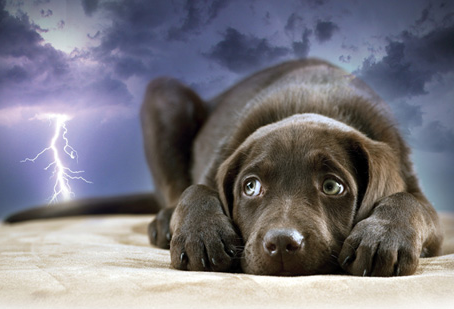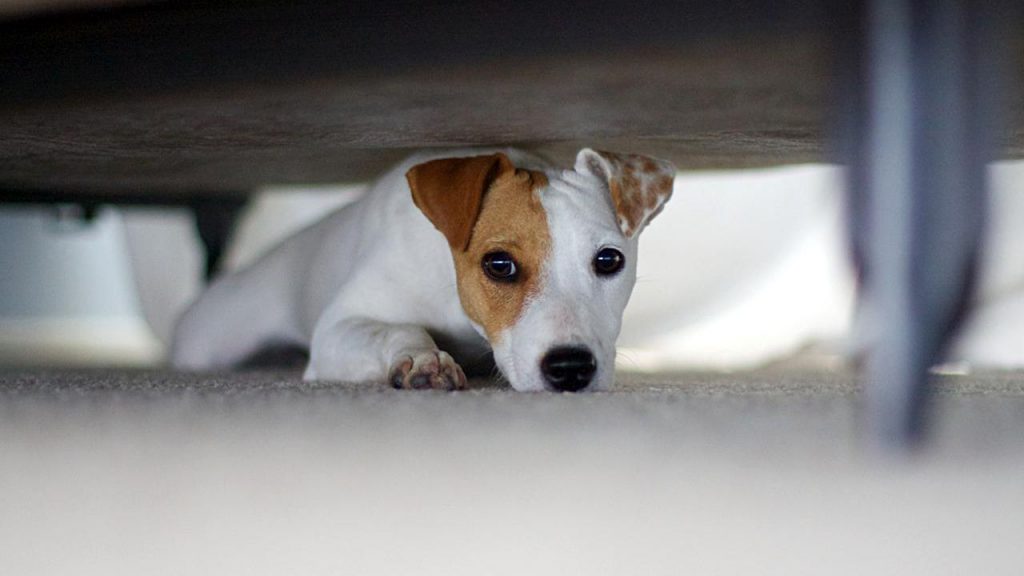It’s that time of year again when we hear many reports of pets suffering from storm phobia. This very real condition is caused by a highly distressing irrational fear beyond any logical self-preservation instinct. It is deserving of our attention and there are effective treatments available.

So why are some dogs utterly terrified by your average storm whilst others barely bat an eyelid?
Affected dogs will have some degree of genetic predisposition to anxious behaviour often compounded by a scary experience of a storm, particularly one that occurred when they were home alone. It’s no surprise that a fear of separation from their owners can also develop in these pets.
What to look out for?
Signs of storm fear resemble what you would equate to a panic attack. These dogs are overwhelmed by fear and we see the full gamut of fear responses:
Fight, Flight, Fiddle and Freeze.
Fight: These dogs are active, agitated and sometimes destructive. They try to escape the experience, pace and pant.
Flight: Hiding in a closet, under a bed, in a bathroom, scratching at doors and windows in an attempt to get away from the storm.
Fiddle: These more subtle signs of anxiety (also called displacement
behaviours) are less known but important signs of anxiety. The dog may yawn when not sleepy, lick lips when not eating, shake off when not wet.
Freeze: This is the poor trembling soul completely paralysed by fear with no way to cope.
Elevated stress hormones can cause dilated pupils, increased salivation and house soiling. Take these signs seriously. The dog that shakes and hides in the corner may be less obvious than the one that is howling, pacing and destroying barriers, however both individuals are suffering from anxiety and need our help.
More resilient dogs may reset to normal soon after the storm, whilst others are anxious throughout the storm season. With repeated traumatic experiences, some dogs generalise their fear to the precursors of storms and become anxious with changes in barometric pressure, wind, rain or overcast conditions.

How can we help?
There are three important aspects to treating any behavioural disorder. We need to manage the environment, train for calm and look at ways to normalise brain chemistry.
Management
Our aim is to reduce our dogs fear by giving them options to avoid the intensity of the storm to a level where they can cope. This is easier said than done and needs to be tailored for each situation.
Mask the noise:
• Play white noise, Spotify is a great source for this.
• Play classical music or music that calms dogs eg “Through a Dogs Ears”. This can also be found on Spotify.
• TV or radio background noise
• Air-conditioning or fan noise.
Mask lightning
• Close curtains and blinds, turn lights on at night
• Offer access to a hiding place without windows
Allow access to a safe place of your dog’s choosing
• Under a bed with blankets pulled down over the edges
• Cover a table or chair to create a safe den
• Protected wardrobes or cupboards
• A crate that has a positive association with the door open
• Choice is mandatory here. Avoid confining your dog against their will. Let them find the place where they feel safest.
Stay with them.
• Dogs are social animals. Your calm presence will make them feel more at ease.
• Yes, it is fine to provide comfort and support. When you dog is in a state of panic, they are not able to think or learn when panicked and you cannot reinforce fear behaviour with cuddles. If they seek comfort, you can help them recover.
• If they are pacing constantly, try popping a lead on and see whether they will sit or lie with you for some calm stroking or massage. Observe their body language and ‘listen’ to what they are telling you.
Adaptil
• This synthetic version of a pheromone produced by lactating
bitches has been shown to promote calm in times of stress. It is a natural approach with no side effects and can be a helpful adjunct to management particularly in milder cases of storm fear. It is available as a spray, collar or diffuser.
Thundershirts
• These work on a similar principle to swaddling a baby. They can help some individuals feel wrapped and protected.
Food
• The food test can give you helpful information. In the height of panic, a dog will not want food. If they will take a favourite treat, this tells us that we are making progress.
• If your dog is able to take a treat during a storm, we can start
some training.
Teaching Calm
Training for calm starts long before the storm event. We first develop simple tools to reward calm when your dog has the mental ease to defer to you calmly for a treat or praise.
Simply teaching ‘Sit’ (treat), ‘Wait’ (treat after a moment delay) and ‘Look’ (lift the treat up beside your eye, meet their eyes softly and treat) rewards calm sitting. Make the treats small, tasty and immediate. Practice several times every day so this becomes second nature. You dog learns that being calm is rewarding.

Only then can you look for opportunities to reward calm when anxiety starts to occur as the weather changes. Training can only help with mild storm anxiety. Once the fear brain has taken over logical thinking, your dog is unable to focus and learn.
Desensitising your dog to the sound of storms using recordings can be helpful in some cases. Choose a time when your dog is relaxed and expose them to the sounds at a level they notice but cope well with. Make sessions short and always stop BEFORE your dog shows any signs of stress. There is a fine line between a non- scary exposure and making them more fearful.
Counterconditioning is about changing the emotional response to the storm from fear to a positive state using a favourite treat or toy. This is combined with desensitisation so that the dog hears the recording of the storm at an intensity they can handle and associates that with the positive experience of a yummy treat or fun game.
Medication
In many cases our dog is so stressed by the storm, that their focus is on self-preservation with no brain space for learning that calm is rewarding. Finding the correct medication to calm that brain can be a life-saving addition to our arsenal against storm fear. Our focus is to reduce anxiety but not sedate the dog. If we can help them overcome that amygdala hijack state and allow the thinking brain to function, we have the option to gain their attention and reward calm. All brains are different, and we can help you to find the most effective medication for your dog. In conjunction with management and training for calm we can improve your dogs welfare during storms.
